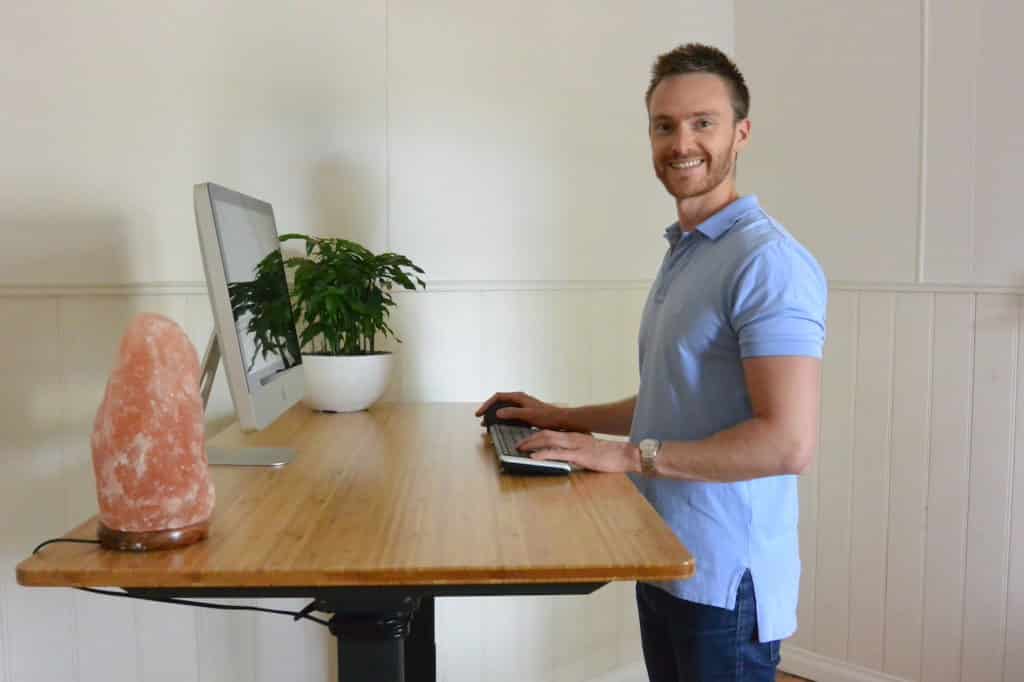Introducing The Up Down Desk | Australias Most Affordable Sit Stand Designed Desk
Recently I have had the pleasure of working with Physiotherapist Jordan Lees who is a registered physiotherapist with a special interest in OHS. He is also the founder of the Up Down Desk which is probably Australia’s most affordable sit to stand manual/electronic sit to stand desk. Many clients that we deal with on a daily basis within our business (Principle Four Osteopathy or Corporate Work Health Australia) are now very much focused on the importance of health and wellbeing in the workplace and many individuals are wanting to avoid prolonged static seated work postures as much as possible for various health and productivity reasons. Below is a recent article written by Jordan that we thought we would share with our readers. To find out more about the Up Down Desk, please go to https://www.updowndesk.com.au/.
Height Adjustable Standing Desks
Written by Jordan Lees, OHS Specialist and the Founder of UpDown Desk
(B. Physio(hons), B. Law)
Height adjustable standing desks are fast becoming a common addition to the office and are something that are commonly recommended as part of an ergonomic assessment, for either injury prevention or injury management.
Here are 5 things to remember when progressing from sitting to standing:
1.There is no need to stand all day. Instead, aim to stand for up to 50% of your working day. One of the main purposes of a standing desk is to enable you to switch between sitting and standing, thereby avoiding prolonged sitting. If you try and stand all day, this would also be classified as a prolonged posture, which is not ideal, and may lead to new musculoskeletal issues. As such, aim to switch between sitting and standing regularly throughout the day, keeping your accumulated standing time to 3 – 4 hours per working day.
2. Progress gradually. If you’ve been desk bound for some time, the muscles that are responsible for holding you upright will be somewhat deconditioned. These muscles are called your postural muscles. When you add in a standing desk, these muscles will be required to do more work. With this in mind, consider a standing desk like a new physical activity, such as going to the gym for the first time. It is important to progress gradually to ensure that your body adapts to the new physical stresses placed upon it. For some guidance on how to do this in relation to standing desks, see the article How Long Should I Stand? Don’t let this concept scare you out of getting a standing desk. We evolved to stand up, not sit down. It’s just important to remember that our modern sedentary lives will have caused some muscular deconditioning, which needs to be recovered gradually.
3.Learn your sitting and standing “threshold”.Both sitting and standing are relatively easy activities. And yet, if we stay in either position for too long, pain or irritation tends to develop. The reason for this is that prolonged postures result in a monotonous accumulation of physical stress to a particular part of the body. If this accumulation reaches the point where the body cannot recover at the same rate that the stresses are accumulating, pain or injury is likely to occur. To avoid this, it is best practice to learn your sitting and standing “threshold”. This refers to the length of time you can comfortably sit or stand in the one position, before you feel you need to move, either due to pain or irritation. Once you know this threshold time limit, never allow yourself to sit or stand in the one position for this length of time. For more information on how to do this, click here.
4. Make sure your desk is set to the correct standing height. Having your standing desk set to the correct height will help to ensure that no new musculoskeletal issues develop. As such, this is very important. See the article Standing Desk Height to learn how to set your desk to the correct height for you.
5. Don’t think standing desks remove the need for physical activity. There is no doubt that standing more, and sitting less, is better for our health and wellbeing. However, having a standing desk does not mean that you will no longer need to exercise regularly. The ultimate way to prevent the adverse health consequences associated with prolonged sitting is to combine a standing desk with regular exercise.
Where to get a standing desk?
When it comes to choosing a height adjustable standing desk, Corporate Work Health recommends and uses UpDown Desk. UpDown Desk provides premium quality standing desks, for an incredibly affordable price. Their desks come with a 5-year warranty, and they deliver and install all across Australia. They also offer ongoing support for the life of your desk.
More information on UpDown Desk can be found at www.updowndesk.com.au.
References
https://www.updowndesk.com.au/how-long-should-i-stand-at-my-standing-desk.html
https://www.updowndesk.com.au/how-long-should-i-stand-at-my-standing-desk.html
https://www.updowndesk.com.au/ergonomic-standing-desk-height.html

